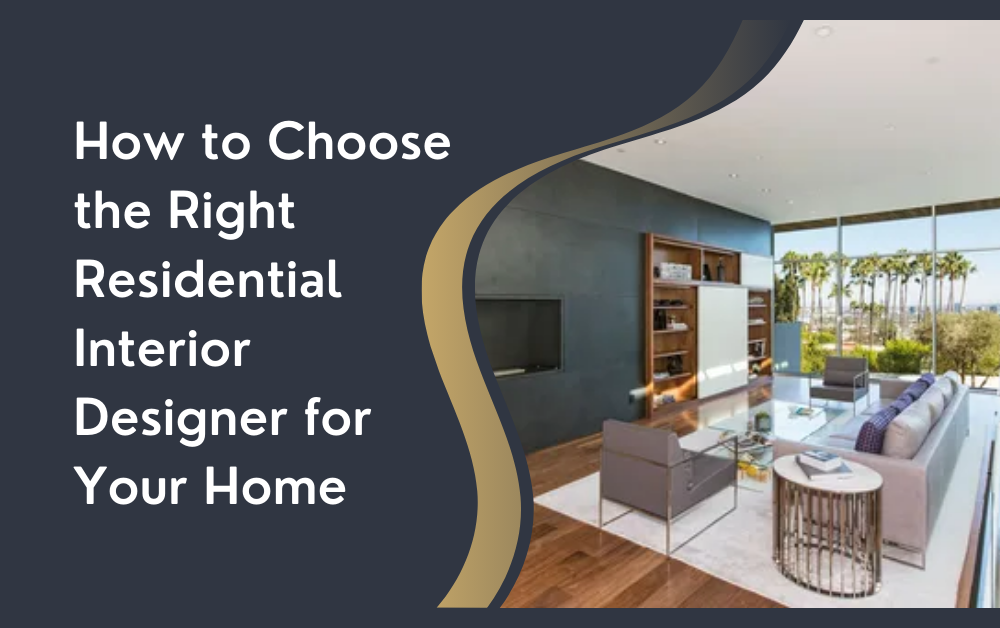Choosing the right interior designer can be one of the most impactful decisions for your home. The right designer can bring your vision to life, while the wrong one can lead to frustration and wasted resources. In this guide, we’ll walk you through everything you need to know to make an informed choice.
Why You Need a Residential Interior Designer
The Benefits of Hiring a Designer
A residential interior designer helps transform your space into something functional, beautiful, and uniquely yours. Here’s why you might need one:
- Expertise: Designers have a deep understanding of design principles and trends. They can offer advice on color schemes, layouts, and materials that you might not consider.
- Time-Saving: Designing a space takes time. A designer can handle the details and logistics, allowing you to focus on other things.
- Cost-Efficiency: While it might seem like an expense, a good designer can help you avoid costly mistakes and get the most value from your budget.
- Access to Resources: Designers often have access to exclusive products and materials not available to the general public.
Note:- If you’re searching for a top-notch residential interior designer Dubai to bring your vision to life, look no further. Our expert team is here to help you create the perfect space that reflects your style and meets your needs.
What to Consider Before Hiring an Interior Designer
Define Your Needs and Goals
Before you start searching for a designer, it’s essential to know what you want. Consider these factors:
- Style and Aesthetic: What kind of look are you aiming for? Modern, traditional, rustic, or eclectic?
- Functionality: How do you use your space? Do you need more storage, better lighting, or a specific layout?
- Budget: How much are you willing to spend? Your budget will influence the scope of the project and the designer’s recommendations.
Research Potential Designers
Once you have a clear idea of what you want, begin your search for a designer. Here’s how to start:
- Referrals and Recommendations: Ask friends, family, or colleagues if they can recommend a designer. Personal experiences can provide valuable insights.
- Online Reviews and Portfolios: Check out designers’ websites and social media profiles. Look at their previous work to see if their style matches your vision.
- Professional Organizations: Look for designers who are members of reputable organizations like the American Society of Interior Designers (ASID) or the International Interior Design Association (IIDA).
How to Evaluate Interior Designers
Check Qualifications and Experience

A designer’s qualifications and experience are crucial in determining their ability to handle your project. Here’s what to look for:
- Education: Many designers have degrees in interior design or related fields. While not always mandatory, a formal education can be a good indicator of expertise.
- Experience: Look for designers with experience relevant to your project. If you’re renovating a kitchen, find someone with a portfolio that includes kitchen designs.
- Certifications: Some designers have certifications from professional bodies. These can indicate additional training and adherence to industry standards.
Review Portfolios and Past Projects
A designer’s portfolio is a window into their work and style. When reviewing portfolios, consider:
- Variety: A diverse portfolio suggests the designer can handle different styles and requirements.
- Quality: Look for high-quality images and well-executed designs. Ensure the projects align with your vision and expectations.
- Client Feedback: If possible, reach out to past clients for their feedback. Ask about their experience working with the designer.
The Design Process
Initial Consultation
Most designers will offer an initial consultation, often free of charge. During this meeting:
- Discuss Your Vision: Share your ideas, needs, and budget. A good designer will listen carefully and provide feedback.
- Evaluate Communication: Pay attention to how well the designer communicates. Clear and open communication is key to a successful project.
- Ask Questions: Inquire about their process, timeline, and fees. Understanding these aspects will help you gauge if they’re a good fit.
Proposal and Agreement
After the initial consultation, the designer will likely provide a proposal. This document should include:
- Scope of Work: A detailed description of the services provided.
- Timeline: A timeline for completing the project.
- Budget: An estimate of costs, including design fees, materials, and any other expenses.
- Terms and Conditions: Terms related to payment schedules, cancellation policies, and other important aspects.
Carefully review the proposal and ensure you understand all terms before signing.
Working with Your Designer
Collaboration and Feedback
Effective collaboration with your residential designer is crucial for a successful project. Here’s how to work well together:
- Be Open and Honest: Share your preferences and any concerns you have. Your designer needs to know your likes and dislikes to create a space you love.
- Provide Feedback: Give constructive feedback throughout the design process. This helps the designer make necessary adjustments and ensures the final outcome meets your expectations.
- Trust the Process: Remember that your designer is an expert. Trust their advice and let them guide you through the process.
Handling Challenges
Design projects can sometimes face challenges. Here’s how to handle them:
- Stay Calm: If issues arise, approach them calmly and professionally. Discuss the problem with your designer to find a solution.
- Be Flexible: Sometimes changes are necessary. Be open to adjustments if they improve the outcome.
- Document Everything: Keep records of all communications, agreements, and changes. This can help resolve any disputes that may arise.
Conclusion
Choosing the right residential interior designer is a significant decision that can greatly influence the success of your home project. By defining your needs, researching potential designers, and collaborating effectively, you can find a designer who will help bring your vision to life. Take your time, ask questions, and make sure you feel comfortable and confident in your choice. With the right designer by your side, you’ll be well on your way to creating a home that’s beautiful and uniquely yours.
Read more informative blog at motoreview.
Bathroom Cleaning Brush with Wiper 2 in 1 Tiles Cleaning Brush with Long Handle 120° Rotate Bathroom Floor Cleaning Brush Floor Scrub Bathroom Brush Home (Yellow-Green-Siver)
₹298.00 (as of 17 October, 2024 18:17 GMT +05:30 - More infoProduct prices and availability are accurate as of the date/time indicated and are subject to change. Any price and availability information displayed on [relevant Amazon Site(s), as applicable] at the time of purchase will apply to the purchase of this product.)RILION 6 fridge storage boxes multipurpose containers for storage Space-saving Refrigerator Side Door Organizer for fridge kitchen Fruits, Vegetables Storage Containers- transparent
₹164.00 (as of 17 October, 2024 18:17 GMT +05:30 - More infoProduct prices and availability are accurate as of the date/time indicated and are subject to change. Any price and availability information displayed on [relevant Amazon Site(s), as applicable] at the time of purchase will apply to the purchase of this product.)Amazon Brand - Solimo 1000ml Stainless Steel Insulated (Thermosteel) Water Bottle | 24 Hours Hot and Cold | Leakproof, Rust and Corrosion Resistant| For Travel, Office, Trekking, Home (Silver)
₹529.00 (as of 17 October, 2024 18:17 GMT +05:30 - More infoProduct prices and availability are accurate as of the date/time indicated and are subject to change. Any price and availability information displayed on [relevant Amazon Site(s), as applicable] at the time of purchase will apply to the purchase of this product.)Perpetual Tea Light Candles Set of 50-100% Pure Wax, Smokeless, Tealight Candles for Home Decoration, 3 Hour Burniong Time Candles for Diwali,Christmas,New Year, Festivals
₹178.00 (as of 17 October, 2024 18:17 GMT +05:30 - More infoProduct prices and availability are accurate as of the date/time indicated and are subject to change. Any price and availability information displayed on [relevant Amazon Site(s), as applicable] at the time of purchase will apply to the purchase of this product.)Perpetual Water Sensor Diya for Home Decoration - 6 Pcs Electric Flameless & Smokeless LED Diya Lights, Candle for Home Decor, Diwali Festivals Decoration,Christmas,New Year, Festive(A)
₹199.00 (as of 17 October, 2024 18:17 GMT +05:30 - More infoProduct prices and availability are accurate as of the date/time indicated and are subject to change. Any price and availability information displayed on [relevant Amazon Site(s), as applicable] at the time of purchase will apply to the purchase of this product.)Discover more from The General Post
Subscribe to get the latest posts sent to your email.





